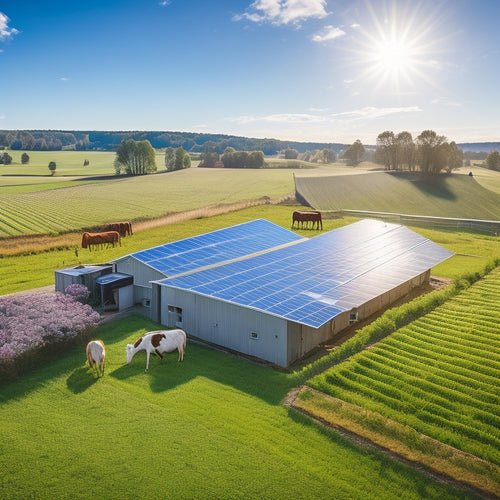
3 Best Home Energy System Maintenance Expenses
Share
You'll need to budget for three key home energy system maintenance expenses to guarantee peak performance and longevity. First, annual panel cleaning costs range from $100 to $300, depending on system size and pollution levels. Second, you'll need to replace your inverter every 10 to 15 years, with installation costs ranging from $2,000 to $5,000. Finally, battery maintenance fees, typically between $100 to $300 annually, are essential for extending lifespan and performance. By factoring in these expenses, you'll be able to maximize your energy savings and system efficiency, and there's more to investigate when it comes to enhancing your home energy system.
Key Takeaways
- Annual panel cleaning costs range from $100 to $300 to maintain peak performance and energy output.
- Inverter replacement expenses, necessary every 10-15 years, can cost between $2,000 to $5,000, including labor and upgrades.
- Regular battery maintenance fees, typically between $100 to $300, help extend lifespan and prevent issues like sulfation and corrosion.
- Effective cleaning and maintenance maximize energy savings and system efficiency, making them crucial expenses for homeowners.
- Budgeting for these expenses ensures optimal performance, reduces downtime, and prevents costly repairs or replacements.
Annual Panel Cleaning Costs
Across your solar panel system, dirt and debris accumulate over time, reducing its energy output. Regular solar panel upkeep is vital to maintain peak performance.
It's important to prevent reduced performance and overheating by regularly checking electrolyte levels and guaranteeing proper water maintenance.
You'll need to factor in annual panel cleaning costs to remove dirt and debris. Depending on the size of your system and location, these costs can vary. On average, you can expect to pay between $100 to $300 per year for professional cleaning services.
For larger systems or those in areas with high levels of air pollution, costs can be higher. Effective dirt removal guarantees your system operates at peak efficiency, maximizing your energy savings.
Inverter Replacement Expenses
Typically, a solar panel system's inverter lasts around 10 to 15 years, depending on the quality of the equipment and environmental factors.
You'll need to plan for inverter replacement expenses as part of your overall maintenance costs. The inverter lifespan can vary, but it's crucial to budget for replacement around the 10- to 15-year mark.
When evaluating your energy storage needs, consider systems with advanced technology like Tesla Powerwall that can optimize energy usage and reduce grid reliance.
Additionally, modular designs from SimpliPhi Power and Rolls-Surrette allow for customized energy storage solutions.
Installation costs for a new inverter can range from $2,000 to $5,000, depending on the type and quality of the equipment.
When calculating your inverter replacement expenses, factor in the cost of the new inverter, labor costs, and any additional upgrades or repairs needed at the time of replacement.
Battery Maintenance Fees
In conjunction with monitoring your inverter's performance, you should also factor in battery maintenance fees as part of your overall home energy system maintenance expenses.
These fees are essential to extending your battery lifespan and ensuring peak system performance. Regular maintenance checks can help identify potential issues before they become major problems, reducing the likelihood of costly repairs or even battery replacement.
Regular solar battery checks identify early warning signs of degradation and prevent sulfation and corrosion, enhancing battery lifespan.
The maintenance frequency will depend on your system's specifications and usage, but you can expect to pay between $100 to $300 per year for routine checks and maintenance.
Frequently Asked Questions
How Often Should I Inspect My Energy System for Potential Issues?
When in doubt, check it out: you should regularly inspect your energy system to guarantee energy efficiency and system longevity, ideally every 3-6 months, to catch potential issues before they snowball into major problems.
Can I Perform Energy System Maintenance Tasks Myself?
You can perform basic DIY maintenance tasks, like cleaning filters and checking connections, but for more complex tasks, it's recommended to hire a professional, as they possess the necessary Energy System Tools and knowledge to guarantee safe and efficient operation.
What Warranty Options Are Available for Energy System Components?
You'll find that manufacturers typically offer warranty coverage ranging from 5 to 25 years for energy system components, such as solar panels, inverters, and batteries, which can provide you with protection against defects and premature failures.
How Do I Troubleshoot Common Energy System Problems?
When your solar panels underperform, you troubleshoot by checking for debris, loose connections, and faulty inverters. For energy efficiency, follow troubleshooting tips like monitoring energy output, inspecting wiring, and consulting your system's manual to identify and fix common issues quickly.
Are Energy System Maintenance Costs Tax-Deductible?
You're likely wondering if energy system maintenance costs can be written off on your taxes. Yes, you can claim tax deductions for energy-efficient upgrades and maintenance that improve your home's energy efficiency.
Related Posts
-

What Do I Need to Know About Farm Solar Panels
When considering farm solar panels, you need to assess costs, benefits, and technical specifics. Initial investment c...
-

Why Outdoor Solar Lighting Systems Are Sustainable
Outdoor solar lighting systems are sustainable because they utilize renewable energy, drastically reducing your carbo...
-

Fastest Solar Chargers for Emergency Power
When choosing the fastest solar chargers for emergency power, you need to focus on features like rapid charging capab...


